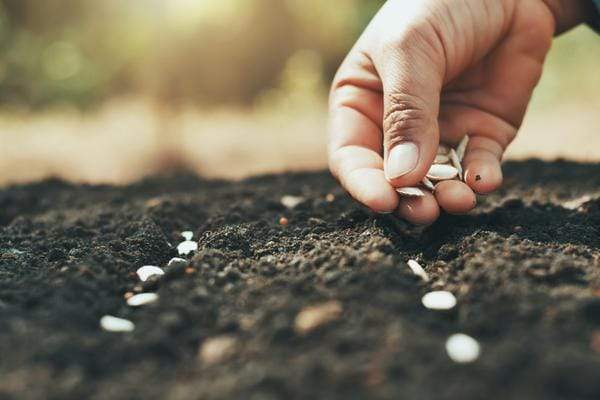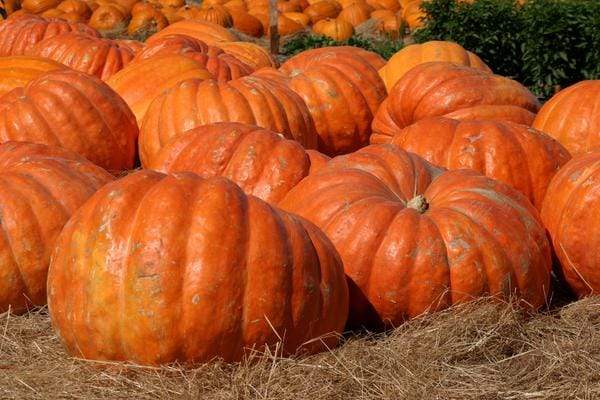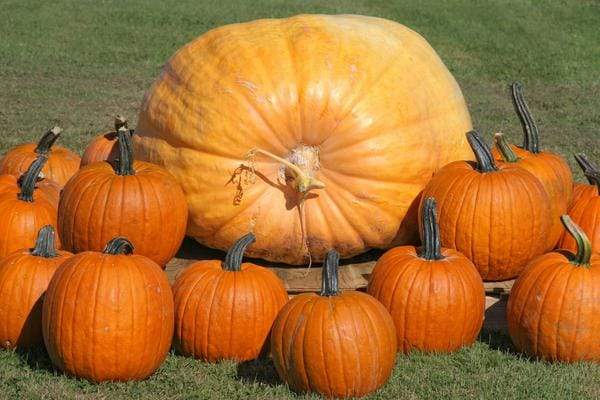If you have ever visited the agricultural exhibits at your county or state fair and wondered how to grow giant pumpkins, our guide below can take you from planting pumpkin seeds to a first-place finish this fall. The secret? Choosing the right variety of pumpkin seeds—and committing to hands-on gardening techniques to pile on the pounds.
How to Grow Pumpkins Successfully
You need:
The right spot and richest soil
Here’s the thing—growing giant pumpkins is really a race to stuff your super-squashes with as much sunshine and nutrients as your growing season can provide. So choose your gardening location carefully!
In a perfect world, your pumpkin will have 10’ of well-tilled soil in a spot that soaks up at least eight hours of sun per day. Good drainage will keep vines and fruit hydrated without encouraging mold, rot, or blight. And you should amend the soil with 6” of compost before you plant.
The winter before you grow your giant pumpkin, build the soil up into a low mound and cover it with compost and some kind of cover or cover crop. All winter long, your soil will absorb important nutrients to support rapid growth in the spring and summer.
Giant pumpkin seeds that grow … and grow … and grow
As the home gardener’s go-to for affordable, heirloom, and non-GMO organic garden seeds, Pinetree Garden Seeds knows just how important it is to start your giant pumpkin project with the right pumpkin seeds. And as any successful giant pumpkin gardener will tell you, every prize-winning pumpkin was grown from some variant of Howard Dill’s famous cultivar.
If you want the best chance at a blue ribbon, try the authentic, tried-and-true Dill’s Atlantic Giant Pumpkin Seeds. And if you purchase your Dill’s from Pinetree Garden Seeds, you will know you are getting the real deal for the right price and not a knock-off.
Starting Giant Pumpkin Seeds Indoors
About a month before your final frost date, plant those giant pumpkin seeds in peat pots indoors. Award-winning pumpkin seeds will not thrive in windowsills! You will want to invest in grow lights and heating pads to provide your pumpkin seeds with radiant heat and steady light. Remember—this is a race and you want your plants to have a real head start.
When your seedlings have put out their first few sets of leaves and the soil temperatures outdoors have warmed to at least 70 degrees Fahrenheit, it is time to think about hardening off your pumpkin plants for transplant.
Planting Out
Identify your healthiest, happiest seedlings and give them some space. Some growers go all-in with just one seedling but most gardeners give several hearty seedlings a chance to show their stuff before winnowing down to one.

Plant no more than three seedlings 24” apart in mounds that are at least five feet apart. If you are in colder microclimates, consider building cold frames around your prized pumpkin plants.
Add nutrients to your soil weekly. At Pinetree Garden Seeds, we encourage organic gardening whenever possible, and there are wonderful organic fertilizers made from seaweed and fish meal. It is possible to plump up a pumpkin to record-breaking weights using only organic methods! No matter how you decide to feed your future fairgoers, however, it is important to match your soil additives to the right stage of growth.
In the spring, prioritize nitrogen for your pumpkin plants. In the summer, pumpkins need more phosphorus. And closer to harvest, power up your pumpkins with potassium. Remember, feed your pumpkin plants some form of fertilizer every single week. All pumpkin plants are heavy feeders. Giant pumpkins are ravenous.
Watch, Work, and Wait
When daytime and nighttime temperatures even out and your seedlings have toughened up, remove the cold frame.
Keep your mounds free of weeds. Giant pumpkins need all the water, nutrients, and sunlight they can get! Don’t let weeds sneak in and steal one precious drop.
If you live in a windy spot, protect your pumpkins with a low fence. You don’t want to block sunlight but you do want to make sure leaves can grow large and flexible enough to soak up all the sunlight.
Inspect leaves for insects, mold, or blight. You are going to want to step up and stop any problems right away.
Grow a Giant
When flowers first appear on the vines, pick them *all* off. You want your vines focused on producing as many leaves as possible to support one enormous pumpkin, not several smaller ones. When flowers form, leaf production slows down. Once your vine has reached 10’ of leafy length, however, you can allow flowers to form, get fertilized, and produce fruit.
After a few weeks, pick off all but the healthiest, heartiest fruit on your vine. Spread sand beneath the baby pumpkin to wick away water and prevent mold.

Sunlight hardens the rinds on pumpkins, and stiff rinds stop pumpkins from growing as large as they can. You need a sunshade over your growing giant to make sure it reaches its fullest potential. (Don’t shade any leaves!)
Remove roots on either side of your pumpkin for several feet. Further down the vine, scoop soil over the growth to encourage roots to form. You want your vine to be flexible close to the fruit and able to suck up water and nutrients from the soil.
Harvest and Transport
With any luck, you’ve grown a gargantuan pumpkin, a sumo squash. So what do you do now? If you plan to exhibit your pumpkin at your local fair, you need to plan ahead. Having a giant pumpkin split or smash on its way to a competition is all too common—and a sad end to a spectacular season.
First, don’t cut your giant pumpkin from the vine until the very last moment. It will begin losing water weight almost immediately and you want every possible pound! Harvest your pumpkin the morning you move it. Even after cutting the stem, some gardeners wrap the cut end in a wet towel or place it in a bucket of water to prevent additional water loss.
Don’t try to move a prize pumpkin alone! Straining to haul a heavy pumpkin can cause back problems or other injuries. Gather friends and family and agree on a plan before you start. Depending on the size of your squash, the distance it needs to travel, and the space you have to maneuver, different approaches may make sense. From tarps to lifts, from car trunks to flatbed trailers, consider all your options and make good, safe choices.
Celebrate the Win
Whether or not you take home a blue ribbon, growing giant pumpkin seeds is a fun family activity, a creative challenge, and a true test of your gardening savvy and stamina. It’s incredible to see what you and nature can do! If you have ever grown a prize pumpkin, post your best advice (or better yet, a photo) in the comments below.
Make the most of your massive pumpkin!
Whether or not you win the big prize, a big pumpkin is a big opportunity for creativity, crafting, composting, and cultivating.
Carve it Up
Turn your enormous pumpkin into a canvas for your creativity! Dill’s Atlantic Giant pumpkins have thick-walled flesh so you can skip hollowing out the pumpkin before you carve and still create wonderful, three-dimensional effects.
Eat it Up
Giant pumpkins are coarser and a lot less appetizing than pie pumpkins, but they can still be consumed … by animals! Ask around to see if any local farmer would be willing to take your giant pumpkin for pig feed.
Sail Away Together
About an hour or so from our rural Maine headquarters, the charming coastal town of Damariscotta draws visitors from all over New England for its famous annual Pumpkinfest. It has all the carving, painting, and cooking contests you would expect but its signature event is the Pumpkin Boat Regatta. That’s right—in this tidal river race, every boat is garden-grown!

Colossal Compost
All the nutrients you fed your giant pumpkin can feed future generations of garden crops. Giant pumpkins can be broken down into gardening gold in your compost.
Save the Seeds
Growing pumpkin seeds from year-to-year? Save money by saving the super-sized seeds from your prizewinning pumpkin.



My first year growing Dill’s gaint pumpkin’s
My biggest one this year weighted in at 205lbs getting more info on growing shooting for the moon next year
Looking forward to buying your Items .specially the giant 🎃.To show my grand children how to begin a garden.